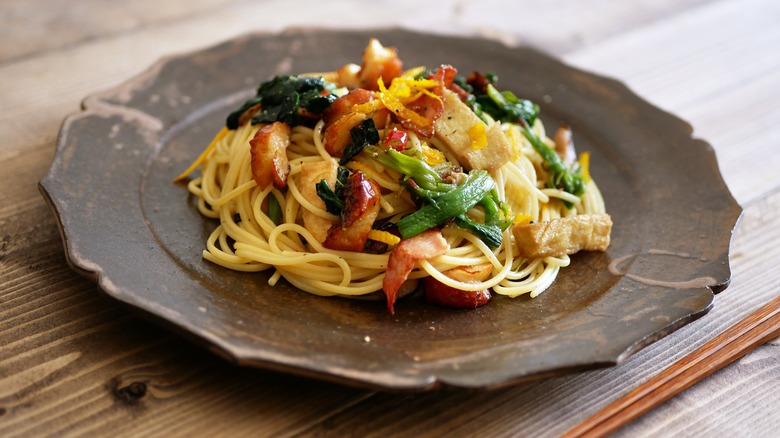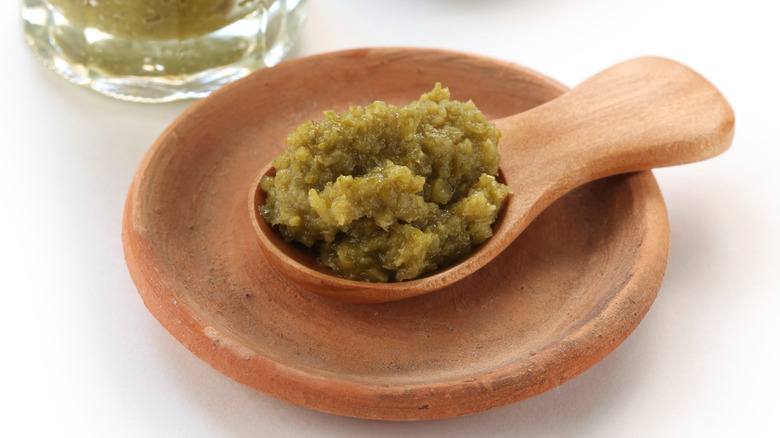Yuzu Kosho Is The Savory Ingredient You Need To Add To Spaghetti Sauce
Pasta sauces can be easily elevated by adding all sorts of extra ingredients to provide a richer, more savory flavor. Parmesan rind is the secret ingredient Giada De Laurentiis adds to pasta sauce for added depth, for example. Other ingredients you should add to a simple spaghetti sauce range from charred tomato paste for extra smokiness to Worcestershire sauce for tangy notes. But if you really want to ramp up the umami taste, then consider another ingredient: yuzu kosho.
The fermented Japanese paste is made from the zest of yuzu, a hybrid citrus fruit that is tart, floral, and zesty, along with red or green chili peppers, and salt. As you might imagine, the result is a powerful combination of flavors — spicy, bright, and full of umami punch — which can be used to enliven pretty much anything you add it to.
Yuzu kosho is traditionally used in Japanese hot pots, soups, and ramen, as well as being served on the side of sashimi as a punchy condiment. But it also works brilliantly when added to spaghetti sauces, bringing a citrusy yet savory element to the dish. Because of how intense the flavor is, you only need to use a little to get a robust-tasting result, making a jar or tube of the paste a budget-friendly purchase that's also incredibly versatile in the kitchen.
Yuzu kosho adds an umami boost to spaghetti sauces
Yuzu kosho can enhance a wide variety of spaghetti sauces. To make an effortless yet richly flavorful sauce, simply fry some garlic in olive oil, add a little pasta water, and dissolve a tablespoon of the paste in it. Toss the cooked spaghetti through, and serve sprinkled with a little paprika or red pepper flakes to add smokiness or extra spice. It's like spaghetti aglio e olio, but with an extra dimension — and the hot, zingy dish is sure to become one of the easiest weeknight pasta recipes in your repertoire.
The punchy paste also goes brilliantly with fish. For a creamy creation, combine two or three teaspoons of yuzu kosho with a half-cup of heavy cream, and mix it with flaked cooked salmon and fresh dill. Toss in cooked fettuccine or spaghetti plus a splash of pasta water for a silky, vibrant, and fragrant dish. Or add a cup of white wine to a pan of garlic sauteed in olive oil, and use the hot liquid to steam clams. Add cooked spaghetti, and stir through a little paste for a fast, flavorsome meal.
Try infusing other pasta or gnocchi dishes with the condiment, too. Creamy tomato gnocchi can be elevated by adding cubes of eggplant fried in olive oil, garlic, and a couple of teaspoons of yuzu kosho. Or use a small amount to brighten your favorite pasta primavera or fettuccine Alfredo recipe.
More ways to use yuzu kosho in savory and sweet dishes
There are many reasons why you need yuzu kosho in your ingredient rotation since it adds extra flavor to a range of recipes beyond pasta sauces. Try mixing a teaspoon with some Greek yogurt and mayo for a bright and tangy dressing for a shrimp cocktail or a vegetable salad, for example.
Yuzu kosho also makes a zippy and tasty marinade or sauce for grilled meat, as its refreshing quality helps to cut through the richness of the protein. Try mixing a little of the piquant paste with miso, sake, mirin, brown or palm sugar, and pepper, then rub the mixture on a flat iron steak. Cover the marinating meat for an hour or so in the fridge before grilling it. It's also delicious with pork chops; add a little sesame oil to the marinade for extra nutty flavor. Or combine a ½ teaspoon of yuzu kosho with garlic, ginger, soy, and mirin, and marinate chicken pieces before grilling on skewers for a spicy-salty treat.
The savory flavor can also be used to elevate sweet dishes — perhaps not quite so surprising when you consider how the similarly umami-rich ingredient miso can transform peanut butter cookies. It goes especially well with pineapple, so try it in cakes featuring the fruit or in a sweet jam used to sandwich cookies. Or add a little to a rich cheesecake mixture for a burst of unexpected flavor and to counterbalance the creaminess.



